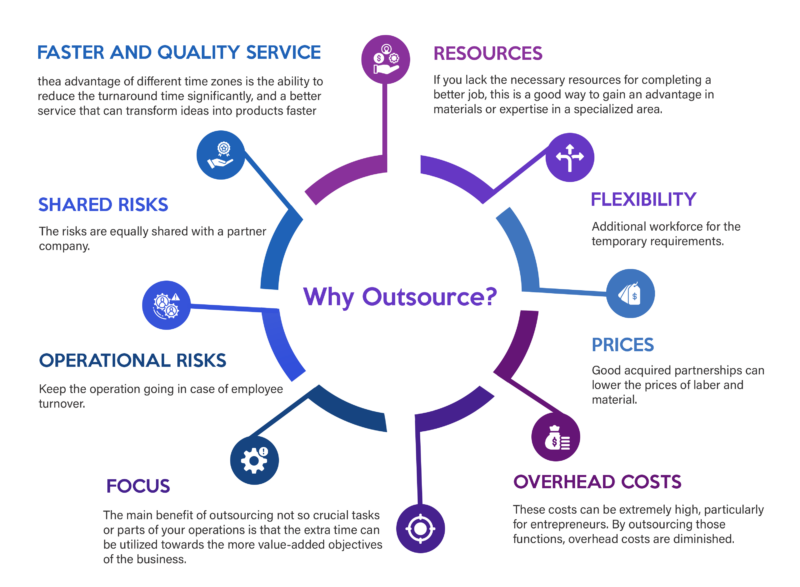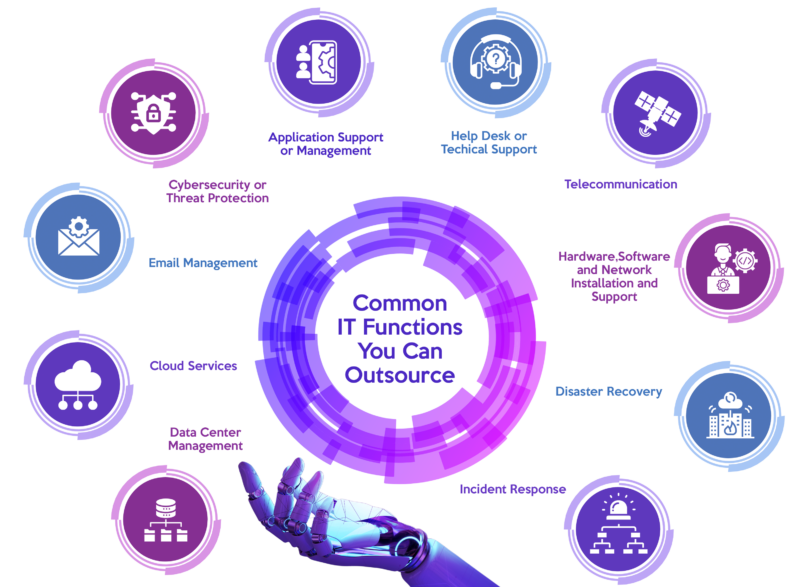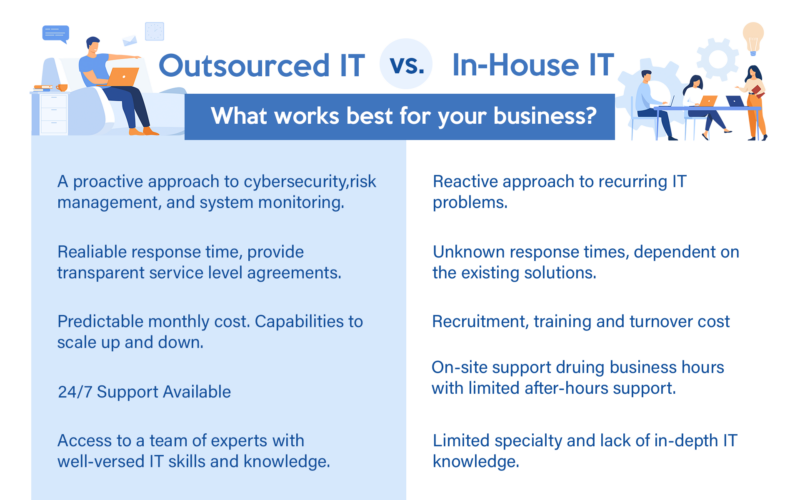Businesses are more reliant on technology than ever before. From managing operations to streamlining communication, Information Technology (IT) plays a critical role in the success of a company.
However, with the rapidly evolving nature of technology, many businesses face the challenge of keeping their IT infrastructure and support services up-to-date and secure. One solution is to outsource IT services, allowing companies to focus on their core competencies while experts manage their technology needs.
This article will explore the costs of outsourcing IT, the factors affecting these costs, and a comparison of outsourcing versus building an in-house IT team.
Why Should Companies Outsource IT?

Outsourcing IT services offer numerous benefits to businesses, including:
Cost Savings
Opting to outsource a third-party provider can significantly lower support costs associated with recruiting, onboarding, and retaining an internal IT and technical support department. This approach not only reduces expenditures tied to human resources but also diminishes the need for businesses to invest heavily in costly hardware and software systems.
By doing so, companies can dodge the issue of allocating resources to technologies that may rapidly become outdated or irrelevant. In this way, outsourcing services provide a more cost-effective and adaptable solution for managing business needs, ensuring that they remain competitive and up-to-date with industry advancements.
Access to Expertise
Outsourcing IT service provider brings an extensive background working with diverse industries, which equips them with the knowledge and expertise necessary to offer valuable insights and recommendations on the most suitable technologies and solutions tailored to your business’s specific requirements.
By collaborating with these seasoned professionals, your company can benefit from their comprehensive understanding of the latest trends, emerging technologies, development process, business processes, and best practices within your sector, ultimately ensuring that your technological infrastructure remains at the forefront of industry advancements. This expertise, in turn, empowers your business to make informed decisions, optimize processes, and leverage innovative solutions to address challenges and achieve strategic goals effectively.
Flexibility
Fully outsourced services provider presents businesses with the flexibility to adapt their technology requirements according to their evolving needs, whether that entails increasing or decreasing the scope of support and services. This adaptable approach guarantees that companies only allocate resources to the specific services they currently require, avoiding unnecessary expenditures on redundant or underutilized solutions.
As a result, businesses can effectively manage their IT expenses, optimizing resource allocation while ensuring that their technological infrastructure remains aligned with their operational objectives and industry demands. This scalability offered by outsourcing is particularly valuable in an ever-changing business environment, where staying agile and adaptable is crucial for long-term success.
Risk Mitigation
When businesses choose to outsource their IT services, they gain access to a team of highly skilled professionals who are well-versed in the most recent security protocols and industry best practices. These experts possess the knowledge and experience necessary to safeguard the company’s digital assets and infrastructure, significantly minimizing the likelihood of data breaches and system downtime.
By entrusting their IT operations to these seasoned specialists, organizations can focus on their core functions with the assurance that their sensitive information and systems are protected by a dedicated team committed to maintaining the highest standards of security and reliability.
As a result, businesses can mitigate potential risks and enjoy enhanced operational stability, ultimately fostering a more secure and resilient foundation for growth and success.
Increased Focus on Core Business Objectives
Choosing to outsource IT services enables businesses to direct their attention and resources toward their core functions and strategic initiatives, effectively streamlining their operations and enhancing overall efficiency. By entrusting their IT needs to a dedicated team of external professionals, organizations can alleviate the burden of managing and maintaining their technological infrastructure, freeing up valuable time and resources to focus on mission-critical tasks and areas that drive growth and revenue.
Consequently, this increased focus on the company’s primary operations can lead to more effective decision-making, optimized processes, and ultimately, greater profitability. In this way, outsourcing IT services serves as a catalyst for businesses to achieve their long-term goals and sustain a competitive advantage within their respective industries..
What Impacts the Cost of Outsourcing IT?
Outsourcing IT services offer numerous benefits to businesses, including:
Scope of Services

The overall expense of outsourcing IT services is contingent upon the variety and extent of the services needed, which can encompass a wide range of tasks and responsibilities. These may include managing the organization’s network infrastructure, overseeing data storage and backup systems, implementing and maintaining robust cybersecurity measures, and developing custom software development tailored to the business’s unique requirements. Each of these services can vary in complexity and scope, necessitating different levels of expertise and resources.
Consequently, the cost of outsourcing IT services will be influenced by the specific combination of these various elements that best align with the company’s needs and objectives, ensuring a tailored solution that effectively addresses their technology challenges and goals.
Level of Expertise
Services or expertise that demand a high degree of specialization or niche knowledge typically carries a more substantial price tag. This increased cost can be attributed to the fact that these specialized services often require professionals with extensive experience, advanced training, or even certifications in specific domains or technologies.
As a result, the rarity and value of these skill sets can drive up the overall expense associated with procuring such services. Nevertheless, investing in highly specialized IT services can yield significant long-term benefits for businesses, as these experts can provide targeted solutions and insights that cater to the unique challenges and requirements of their specific industry or market segment.
Geographical location
Opting for managed service provider located in regions with lower living expenses can lead to considerable cost reductions for businesses. These savings can be attributed to the more affordable labor and operational costs prevalent in such areas.
However, it is crucial for organizations to be mindful of potential challenges that may arise from language barriers and time zone differences, which can hinder effective communication and impede efficient project management.
Size of the Business
As a general rule, the size and scale of a business tend to correlate with the complexity and scope of its IT needs, resulting in increased outsourcing costs for larger organizations. This can be attributed to the fact that bigger companies typically have more employees, a broader customer base, and more extensive operations, all of which necessitate more intricate and sophisticated IT solutions. This may include advanced network infrastructures, robust cybersecurity measures, comprehensive data storage and management systems, and highly customized software applications.
Given the higher level of complexity associated with these IT requirements, larger businesses often need to engage with IT outsourcing providers that possess the necessary resources, expertise, and capacity to manage and maintain their technology infrastructure effectively. This, in turn, can lead to higher outsourcing costs, as the providers must allocate additional resources to meet the specific demands of these larger organizations. However, the investment in more comprehensive IT services can yield significant long-term benefits, enabling businesses to optimize their operations, enhance their competitive edge, and drive growth more effectively.
Contract Length
Establishing long-term contracts with IT outsourcing providers can lead to notable savings, as these arrangements often include discounted rates or bulk pricing incentives in exchange for a more extended commitment. This option can be particularly appealing for businesses seeking a stable, ongoing relationship with their IT service provider, ensuring consistency and reliability in their technology infrastructure management.
On the other hand, short-term contracts can offer businesses increased flexibility in their IT outsourcing decisions. This approach allows organizations to evaluate and reassess their technology needs more frequently, making it easier to adapt to changing circumstances, industry trends, or evolving business objectives.
While short-term contracts might not provide the same savings as their long-term counterparts, the added flexibility can be advantageous for companies navigating an uncertain or rapidly changing business environment.
Average Cost to Outsource IT
Outsourcing IT costs can vary widely depending on the factors discussed above. However, to give you an idea of what to expect, here are the average costs for different business sizes:
Small Businesses
IT outsourcing for small business can range from $1000- $3500 per month, depending on the complexity and scope of services required.
Mid-sized Businesses
For companies with more employees, an extended team, and infrastructure, the average cost can range from $5,000 per month.
Large Companies
The cost for large enterprises can start at $8,000 to $15,000 per month and go up depending on the organization’s size, complexity, and specific needs.
Outsourcing IT vs. Building an In-house IT Team: Direct Comparison

To understand the cost differences between outsourcing IT and building an in-house team, let’s consider three key areas: Initial Setup, Ongoing Expenses, and Total Cost of Ownership.
Initial Setup
Outsourcing IT
When businesses choose to outsource their IT services, they can typically expect lower initial setup costs compared to establishing an in-house IT department. This is primarily because outsourcing alleviates the need for businesses to make significant investments in hardware, software, or the development of physical infrastructure, such as server rooms, workstations, and other many factors. In the case of outsourcing, the responsibility for acquiring and maintaining these resources falls on the IT service provider, allowing businesses to save on upfront expenditures.
Outsourced IT support is equipped with the necessary infrastructure, tools, and technology to support the diverse needs of its clients. By leveraging these existing resources, businesses can avoid the often substantial costs associated with purchasing and maintaining their own equipment and software, as well as setting up the physical spaces needed to house them.
This cost-effective approach enables organizations to allocate their financial resources more strategically and focus on their core competencies, ultimately driving efficiency and growth.
In-house IT team
Creating an in-house IT department necessitates considerable initial investments in various aspects of the operation, including the recruitment and training of skilled personnel, procurement of hardware and software, and the development of the physical infrastructure required to support the IT functions. This infrastructure typically encompasses server rooms, workstations, and other essential components that facilitate seamless and efficient IT operations within the organization. per month.
The process of hiring and training IT staff can be both time-consuming and expensive, as businesses need to identify, attract, and onboard individuals with the right skill sets and qualifications. Furthermore, investing in the latest hardware and software technologies can be a costly endeavor, particularly given the rapid pace at which technological advancements occur.
Additionally, the establishment of the necessary physical infrastructure involves not only the allocation of space within the company’s premises but also the costs associated with designing, constructing, and maintaining these areas to ensure optimal performance and security. In light of these factors, businesses must carefully weigh the benefits and potential return on investment when considering the establishment of an in-house IT department.
Ongoing Expenses
Outsourcing IT
Ongoing costs for outsourcing managed service providers can include monthly fees, service-level agreements, and any additional costs or services required. However, these costs are often predictable, allowing for better budget management.
In-house IT team
Ongoing expenses for an internal IT team include in-house employee salaries since you’ll be hiring expert human resources such as a project manager, network monitoring personnel, benefits, office rent that has hidden costs, equipment maintenance, and software licenses. These costs can fluctuate, making budgeting more challenging.
Total Cost of Ownership
Outsourcing IT
The total cost of ownership for outsourcing IT can be more manageable due to predictable monthly expenses and the potential for savings through economies of scale.
In-house IT team
The total cost of ownership for an in-house IT team can be higher, particularly when considering the costs of hiring, training, and retaining skilled IT professionals, as well as investments in hardware and software.
Choosing the Right IT Outsourcing Provider
Selecting the right IT services provider is crucial for ensuring that your business’s technology needs are met effectively and efficiently. Here are several key factors to consider when choosing the right provider for your organization:
Expertise and Experience
Assess the provider’s technical knowledge, industry experience, and the qualifications of their team members. It is essential to choose a provider with a strong track record in delivering IT solutions for businesses similar to yours, both in size and industry.
Range of Services
Consider the provider’s range of IT services and their ability to cater to your specific needs, such as network management, cybersecurity, data storage, and software development.
Scalability
Evaluate the provider’s capacity to scale their services as your business grows and evolves. This flexibility is vital for ensuring that your IT infrastructure can adapt to changes in your organization’s size, operations, or strategic objectives.
Communication and Responsiveness
Gauge the provider’s communication skills and responsiveness to client inquiries or concerns. Effective communication is crucial for a successful IT partnership, so choose a provider that is easy to communicate with and promptly addresses any issues that may arise.
Security and Compliance
Investigate the provider’s security measures and their ability to help your business comply with industry-specific regulations and standards. This is particularly important in industries that handle sensitive information, such as finance or healthcare.
Cost and Value
Compare the cost of the IT services offered by different providers, taking into account both upfront and ongoing expenses. While cost is an essential factor, it should not be the sole determinant; focus on the value and return on investment that the provider can deliver.
Reputation and Testimonials
Research the provider’s reputation in the industry by reading reviews, testimonials, and case studies. This can give you a sense of the quality of their services and the satisfaction of their clients.
Service Level Agreements (SLAs)
Review the provider’s SLAs to ensure they align with your expectations for service quality, response times, and system uptime. Clearly defined SLAs can help set the foundation for a successful IT outsourcing relationship.
By carefully evaluating these factors, you can make an informed decision when choosing the right IT services provider for your business, ensuring a successful partnership that helps drive growth and success.
Bottomline
Outsourcing IT services can be a cost-effective solution for businesses of all sizes. Not only can it save on initial setup and ongoing expenses, but it also offers access to a broader range of expertise and resources than an in-house team. Furthermore, outsourcing can help mitigate risks associated with cybersecurity and system downtime, allowing businesses to focus on their core competencies and drive growth.
When considering the costs of outsourcing IT versus building an in-house IT team, it’s essential to consider the size of your business, the complexity of your IT needs, and your long-term goals. While the initial investment in an in-house IT team may be higher, some businesses may find value in having direct control over their IT infrastructure.e growth.
On the other hand, outsourcing IT offers the flexibility to scale services up or down as needed, making it an attractive option for businesses looking to manage costs and maintain a competitive edge in a rapidly changing technological landscape.



Leave A Comment
You must be logged in to post a comment.